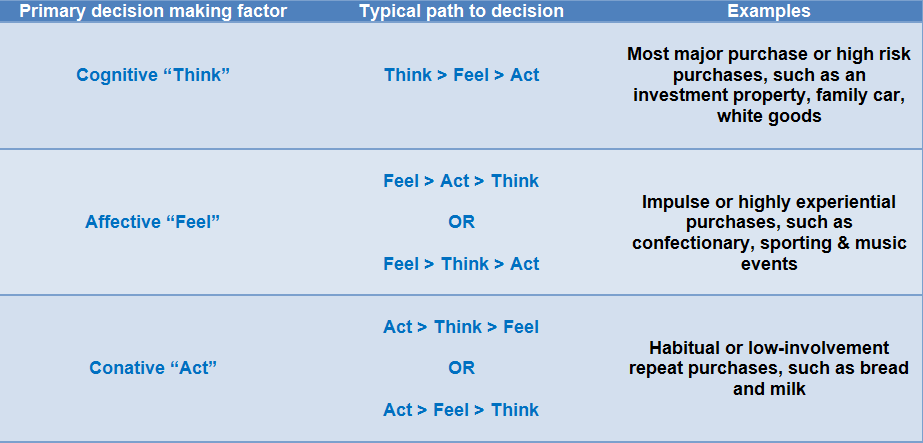Buyer behaviour research is an approach that considers both the current and future state within the context of consumer needs and wants. More than just identifying gaps and opportunities, it delves into how those opportunities can be realised. Buyer behaviour research includes factors that impact on overall decision making process and information search, including both internal and external influencing leading to product and service purchase.
Buyer behaviour research is normally first conducted in focus group form, before quantifying the opportunities via surveys. In essence, this approach:
- Answers the questions of what, where, when, how and why purchases are made.
- Identifies the interplay of personal, social and psychological factors on the purchase decision.
- Guides the execution of the marketing mix, identifying the types of marketing/sales strategies that are needed to have the greatest impact on purchase decisions.
- Models the buyer behaviour process, allowing marketing teams access to more informed decisions on how specific strategies and tactics influence sales results.
- Explores new opportunities presented by the external environment, including emerging technologies and social changes.
Tip 1: Map the stages in the journey
While the speed of decision making varies by individual and product category, invariably consumers progress through six common key stages. Each of these stages form an important landmark along the customer journey, with opportunities for organisations to influence the ultimate decision made. In brief, these six stages cover:
- Problem recognition or awareness of a need
- Information search – this process covers both a scan of internal sources (eg current awareness of brands/products that might fit the need) and external sources to create the consideration set (or evoked set)
- Evaluation of alternatives – how does the consumer evaluate and what weighting is given to each decision factor
- Purchase decision – which brand/product will be chosen, and how does the consumer intend to purchase it
- Actual purchase – ie the behaviour
- Post-purchase evaluation – was the initial need satisfied? Has the problem been resolved?
Tip 2: Understand the hierarchy of decision making processes
The customer journey that leads to purchase (ie buyer behaviour process) can be as short as a few seconds – as in the case of repeat, impulsive and habitual purchases, or can take several years – as in the case of purchasing a home. Consequently, when developing a buyer behaviour model for your brand, it is important to understand the type of decision making process employed. Most decisions are influenced by cognitive, affective or conative elements, but to what degree and in which order? What is the interplay between these factors.
Tip 3: Determine the internal influences on the individual
While every consumer is different and unique, uncovering common internal influences at play provides opportunity to better target offerings to the market. These internal influences typically span two main categories:
- Personal influences – demographics, role within the household purchase situation, intended function, usage situations, social norms
- Psychological factors – motives, personality, attitudes, lifestyle, perceived status (and desirability of being aligned to a particular brand)

Tip 4: Identify opportunities in the external environment
No purchase decision happens in isolation. There are a range of factors external to the consumer that influence choice. The five most common external factors influencing purchase decisions include:
- Social influencers – role of opinion leaders, social networks and word of mouth
- Marketing influences – brand, sales promotions, advertising, product and information channels, etc
- Economic influences – consumer/business confidence, interest rates, inflation
- Market/category factors – level of competition, level of choice available
Technology factors – usage of and influences from technology, and the emerging role of smartphones as both a purchase and service delivery channel
Tip 5: Re-evaluate your buyer behaviour model regularly
While this last tip is fairly self-explanatory, it is critical to ongoing success because change happens to all markets, consumers, products and services. To ensure that the marketing strategy continues to leverage the greatest opportunities, the key elements of the model should be regularly evaluated. Consider validating key elements in your regular research program for early signs of changes in buyer behaviour. Additionally, use regular monitoring of your internal big data sources (such as transaction data and enquiry channel) to pick up early signs of change.

